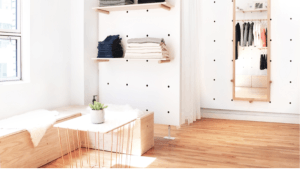AYR: Immersive online experience with a real-world twist

Bonobos sister company makes shopping for the perfect pair of jeans something to look forward to
Less than two years after its launched, online retailer AYR (All Year Round, pronounced like “air”) has grown its initially small line of basic womenswear into a robust online shopping experience for the 30-something year-old who is too busy to shop brick and mortar. Launched as the first womenswear label under online menswear retailer Bonobos, AYR takes advantage of its parent companies vertically-integrated infrastructure and proven business model, which in my opinion makes them a digital winner.
 AYR promises customers a line of high-quality, simple basics that are usually hard to find and that can be worn all year round, hence the label’s name. By putting a strong strategic emphasis on sourcing the highest quality fabrics from all over the world, AYR is able to charge premium prices for basic pieces it believes all women want to have in their wardrobe. Its crown jewel are denim jeans – according to Vogue, AYR achieved the impossible by “creating form-flattering jeans with all the stylistic appeal of their vintage predecessors.”
AYR promises customers a line of high-quality, simple basics that are usually hard to find and that can be worn all year round, hence the label’s name. By putting a strong strategic emphasis on sourcing the highest quality fabrics from all over the world, AYR is able to charge premium prices for basic pieces it believes all women want to have in their wardrobe. Its crown jewel are denim jeans – according to Vogue, AYR achieved the impossible by “creating form-flattering jeans with all the stylistic appeal of their vintage predecessors.”
Similar to Bonobos, AYR’s business model allows the label to execute on its strategy by creating value on both the digital and the physical dimension. Digitally, AYR has a very attractive and user-friendly website (https://ayr.com/) which is designed to reflect the simple-yet-stylish image of the brand and has won multiple AWWWard awards. For each piece, detailed information about the fit and fabric highlight the value AYR creates, which brings me to the physical dimension.
 AYR takes the online shopping experience offline in two major ways. First, shoppers can use the Home Try On feature to have up to three different sizes of the same pair of denim delivered to their door-step; AYR then gives shoppers up to one week to decide which one (if any) fits the best and only charges the customer once she selected a keeper. Second, AYR has what it calls a Guideshop (a small showroom that displays its entire line) at its New York headquarters. This allows shoppers the option to book an appointment for trying on clothes in a more traditional retail setting and it allows AYR to receive real-time feedback on its line on a regular basis.
AYR takes the online shopping experience offline in two major ways. First, shoppers can use the Home Try On feature to have up to three different sizes of the same pair of denim delivered to their door-step; AYR then gives shoppers up to one week to decide which one (if any) fits the best and only charges the customer once she selected a keeper. Second, AYR has what it calls a Guideshop (a small showroom that displays its entire line) at its New York headquarters. This allows shoppers the option to book an appointment for trying on clothes in a more traditional retail setting and it allows AYR to receive real-time feedback on its line on a regular basis.
While value creation happens at both the physical and digital level, AYR captures value exclusively online. Even though shoppers have various choice for how they can try on clothes (i.e., home try on, the Guideshop, regular online shopping), all roads lead them to the online purchasing portal. When I visited their Guideshop last summer, for example, I had a personal consultant who convinced me to buy a few pieces that were not in my price range, but oh the fabric was so nice and I would were them for years, wouldn’t I? To purchase what I had selected, the AYR employee sat down with me and walked through their website, exactly the same way I would if I was sitting on my sofa at home buying clothes online. I even had to live with the delayed gratification of online shopping rather than buying my clothes on the spot – but with free 1-2 delivery I was still a happy shopper.



I remember hearing about the launch of AYR, but never followed up on how the product offerings evolved. Thanks for the update and the interesting read! It sounds as though AYR has been successful to date with its branding, user experience, and business model. However, in recent years, it seems like there’s been a proliferation of similar online retailers such as Everlane, Cuyana, Warby Parker, etc. Online retailers like Everlane actually have similar target audiences and value propositions. With all of these digital innovators entering the market, I wonder which companies will really survive the test of time. What do you think will determine the winners vs. losers in online retail specifically?
Thanks for sharing this. I haven’t heard of AYR before, so this was an interesting read. While I like that AYR operates under a reputable parent company, I still worry about how these online retailers can truly differentiate themselves in the long run. I feel like the marketplace is slowly getting saturated with online retailers that offer a home try on type of feature that it will stop becoming a “differentiating factor.” I recognize that there have been efforts to open brick and mortar show rooms to help build brand recognition, but most of these showrooms are in large metropolitan cities and not easily accessible by large parts of the population. This was just a thought that came to mind as I was reading this.
Thanks Sherry and HBStudent2016. I definitely see your concern about differentiation through the digital and home try-on aspects alone and agree that this is becoming a crowded market place. I think AYR uses the digital experience as table stakes…the basics that they have to get right. What I think they actually see as their competitive advantage is the design and quality of their clothes, specifically jeans. In that sense, they have to play the same game traditional labels have played for decades, which is finding the secret sauce to set themselves apart in the minds of the customers by doing one thing really well for a specific target audience.
Looks like they have been able to be quite successful but indeed I agree with Sherry that it seems like similar business models are pretty widespread today in the US and even outside. For example, the French brand Sezane just opened their physical showroom in Paris to complement their online-only sales model. I think that retail fashion is definitely a field with enough space for a large number of players but do wonder what the lower barriers to entry and broad possible access will mean in the future for that industry.